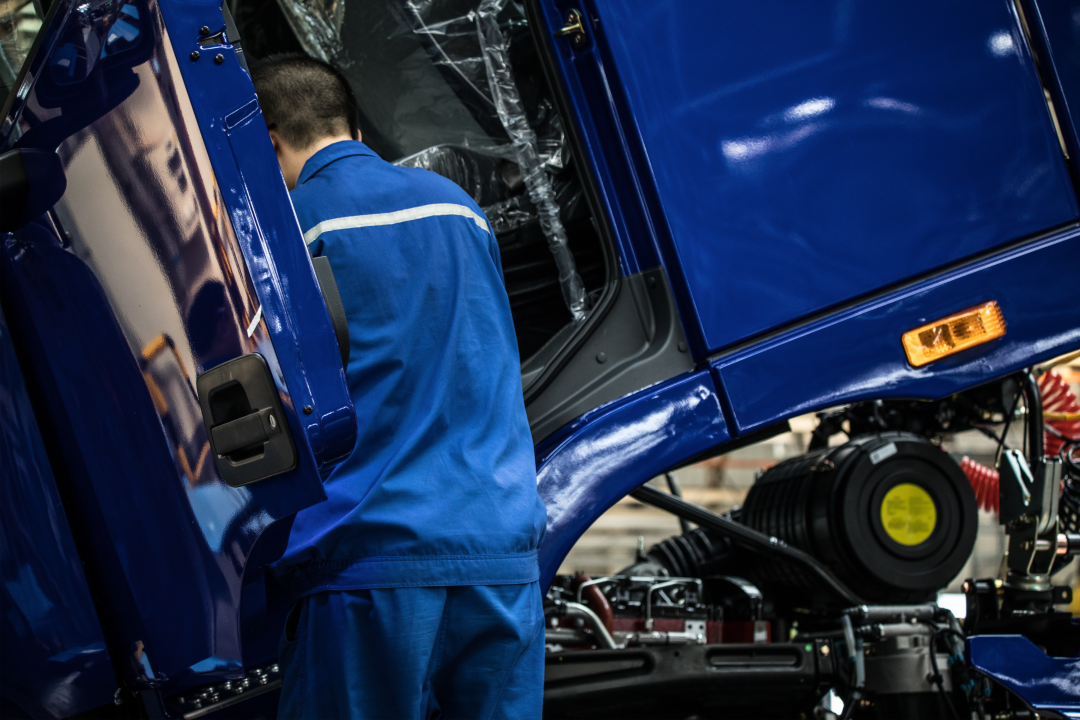
Susie Jones
Lastbilchauffører med handicap - hvilken støtte er tilgængelig?
Oprettet: 12.08.2024
•
Opdateret: 12.08.2024
I Storbritannien rapporterede [23 %] (https://commonslibrary.parliament.uk/research-briefings/cbp-7540/#:~:text=There%20were%209.58%20million%20people,of%20the%20working%2Dage%20population.) af befolkningen i den arbejdsdygtige alder, at de var handicappede - uden at mange vidste det, består en stor del af dem af lastbilchauffører, der kører i en uendelighed på tværs af Europa for at levere dine varer. Selv om de står over for mange udfordringer, understreger deres tilstedeværelse i lastbilsamfundet vigtigheden af inklusion og mangfoldighed i branchen.
Kan jeg køre lastbil, hvis jeg har et handicap?
Hvis du har et fysisk eller kognitivt handicap, kan du godt køre lastbil. Du skal dog bestå en lægeundersøgelse for at afgøre, om du er egnet nok. En lægeundersøgelse består af følgende:
En samtale med en læge om dit helbred: Chauffører skal være ærlige og åbne.
En fysisk undersøgelse, hvor din læge vil tjekke:
Blodtryk
Hjerte
Vision
Test for diabetes
Neurologiske tilstande
Søvnforstyrrelser.
Når det er gennemført, afgør DVLA, om du må køre bil.
Justeringer af lastbilen
For chauffører med fysiske handicap er følgende modifikationer tilgængelige:
Håndbetjeninger til erstatning for pedaler
Hjælpemidler til styring
Acceleratorer til venstre fod
Ombygning af kobling
Seler
Specialiserede siddepladser
Udstyr til opbevaring af kørestole.
I 2021 tilpassede lastbilproducenten MAN fire [lastbiler til handicappede chauffører] (https://trans.info/check-out-the-lorries-man-altered-to-accommodate-disabled-drivers-228342). Tilpasningerne indebar, at lastbilerne blev udstyret med en løfteplatform, så kørestolsbrugere nemt kunne få adgang til kabinen - med alle betjeningselementer monteret på eller omkring rattet.
Selv om teknologi og tilpasninger er på vej frem i branchen, står mange handicappede chauffører stadig over for udfordringer på jobbet.

Hvilke forhindringer møder handicappede lastbilchauffører?
Det kan være svært for handicappede chauffører at komme ind i branchen, selv om de har de nødvendige kvalifikationer og har bestået deres lægeundersøgelse. Mange virksomheder er tilbageholdende med at stille et tilpasset køretøj til rådighed, da det kan være en dyr investering.
For chauffører, der er villige til at betale for de nødvendige tilpasninger, siger Andy, CEO for velgørenhedsorganisationen [Globe Truckers UK] (https://www.globetruckersuk.org/), at det stadig er en udfordring at finde arbejde.
"Nogle transportvirksomheder er tilbageholdende med at ansætte handicappede - de er ofte på vagt over for de forhindringer, chaufførerne møder uden for førerhuset, for eksempel trapper og løft."
David Chambers, en handicappet lastbilchauffør, har udtalt sig om de prøvelser, han møder dagligt, og har opfordret til rimelige justeringer af ligestillingsloven - især efter at regeringen opfordrede til, at flere mennesker på invaliditetsydelse skulle vende tilbage til arbejdet.
David og mange andre har det svært på store depoter, hvor depotet i henhold til [ligestillingsloven] (https://www.legislation.gov.uk/ukpga/2010/15/contents) ikke er forpligtet til at foretage rimelige tilpasninger for chauffører med handicap. Af sikkerhedsmæssige årsager skal de vente væk fra deres lastbiler, mens de læsser af, hvilket betyder, at de skal gå lange afstande og op ad trapper.
Hvilken støtte er der til handicappede lastbilchauffører?
Det kan være besværligt at finde støtte til dem, der har fået livsforandrende skader eller sygdomme. Den britiske velgørenhedsorganisation Globe Truckers blev bygget målrettet af chauffører for at hjælpe chauffører - ved at yde støtte til skadede, syge eller handicappede.
"Mange handicappede eller tilskadekomne bilister ved ikke, hvor de skal henvende sig, da der er meget lidt information til dem derude. Det er her, vi kommer ind i billedet og tilbyder vores støtte og vejledning - hvad enten det drejer sig om at henvise dem til de rette personer eller at finansiere udstyr."
"Nogle chauffører har bare brug for nogen at tale med, og vi er her for at tilbyde dem den støtte på enhver mulig måde. I fremtiden vil vi meget gerne kunne finansiere tilpasninger af lastbiler til chauffører. Tilpasninger kan være meget dyre, og de fleste handicappede chauffører må betale af egen lomme. For at opnå dette har vi brug for mere finansiering og støtte fra dem i branchen," siger Andy.
Hvordan kan branchen hjælpe?
For at skabe et mere inkluderende og mangfoldigt landskab skal branchen gøre mere for at imødekomme fysiske og kognitive handicap - en ændring, der skal ske snart, siger Andy.
"Det er vigtigt, at branchen giver sin støtte og tid tilbage til sig selv, hvad enten det er direkte til handicappede chauffører eller velgørenhedsorganisationer som Globe Truckers. Branchen kan ikke forvente at appellere til folk, hvis de ikke yder støtte til minoriteter."
Som et fristed for mange chauffører kan truckstops bane vejen ved at tilbyde tilgængelige faciliteter. I 2022 investerede regeringen [100 millioner pund] (https://www.gov.uk/government/news/up-to-100-million-boost-to-improve-hgv-roadside-facilities) i branchen for at forbedre faciliteterne langs vejene og skabe mere sikre lastbilparkeringer.

Den statslige finansiering kan forbedre tilgængeligheden for handicappede bilister ved populære stoppesteder. Ændringer som de følgende kan have stor betydning:
Kørestolstilgængelige parkeringspladser: Chauffører, der har svært ved at komme ind og ud af førerhuset, har brug for ekstra plads - især til dem, der har brug for en lift.
Tilgængelige faciliteter: Tilgængelige restauranter, toiletter og andre faciliteter sikrer et inkluderende miljø.
Flådevirksomheder kan hjælpe med at skabe et mere inkluderende miljø ved at gennemføre følgende foranstaltninger:
Ombygning af lastbiler - så de er nemme at betjene for handicappede chauffører via håndbetjeninger og adaptive teknologier.
Støtte og uddannelse - tilbyde kurser, der tager fat på specifikke udfordringer eller behov.
Inkluderende ansættelsespraksis - en fordomsfri tilgang til ansættelse fremmer en inkluderende og mangfoldig kultur.
En mangfoldig og inkluderende kultur er afgørende for at tiltrække flere chauffører til transportbranchen. Støtte til personer med fysiske og kognitive handicap er blevet overset af branchen, og mange chauffører ved ikke, hvor de skal henvende sig. Handicappede chauffører tilbyder et unikt synspunkt og en tilpasningsevne, som er en velkommen forandring i branchen.
Hvad skal jeg gøre, hvis jeg bliver handicappet i løbet af min karriere?
Hvis du udvikler en "anmeldelsespligtig" sygdom eller et handicap, skal du gøre DVLA opmærksom på det - DVLA vil gøre følgende:
Beslut dig pr. brev - nogle omstændigheder kan kræve mere information.
Vurder din medicinske tilstand, og beslut dig for udfaldet.
Hvis du har brug for at tilpasse dit køretøj, skal du have en uafhængig vurdering af dine [tilpasninger] (https://www.drivingmobility.org.uk/).
Hvis du skal holde op med at køre, vil DVLA give dig en medicinsk begrundelse.



